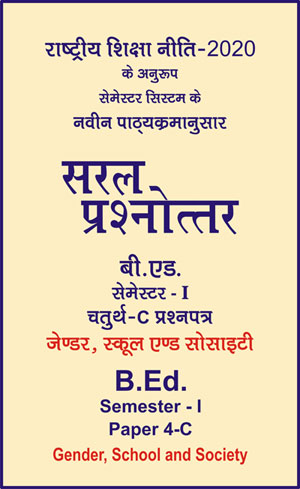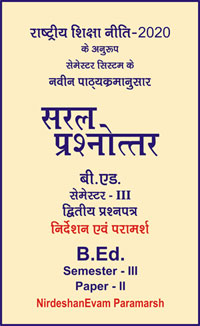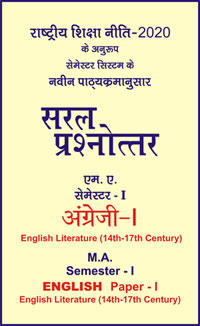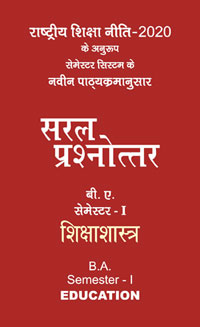|
बी एड - एम एड >> बी.एड. सेमेस्टर-1 प्रश्नपत्र-IV-C - जेण्डर, स्कूल एण्ड सोसाइटी बी.एड. सेमेस्टर-1 प्रश्नपत्र-IV-C - जेण्डर, स्कूल एण्ड सोसाइटीसरल प्रश्नोत्तर समूह
|
|
||||||
बी.एड. सेमेस्टर-1 प्रश्नपत्र-IV-C - जेण्डर, स्कूल एण्ड सोसाइटी (अंग्रेजी भाषाा में)
Chapter 15 - Reservation for Women, Supreme Court Verdict about Transgender
Question- How are reservation and women empowerment interrelated?
Related Short Answer Questions
-
What is meant by Empowerment?
- What is the role of women in society?
Answer -
On June 4, 2009, in the first session of the Fifteenth Lok Sabha, President Pratibha Patil announced in a joint sitting of both the houses that the government would take steps to get the Women’s Reservation Bill passed in the Legislative Assemblies and Parliament within a hundred days. Addressing both the houses, President Pratibha Patil put forth the intention of the government regarding women’s reservation.
According to the President, women have to be deprived of many opportunities due to class, caste and being women, therefore steps will be taken to make constitutional amendments in the next 100 days to give 50 percent reservation to women by increasing the reservation in panchayats and urban local bodies so that to enable more women to enter the public sector, the government will try to increase the representation of women in central government jobs in the next 100 days, along with a step to establish a national mission on women empowerment for better coordination.
The 15th Lok Sabha has created history in many ways. Women empowerment is no longer an issue of political circles, but a reality of the 15th Lok Sabha. This is the first time that the number of women entering Parliament is more than 50. Not only this, the biggest thing is that for the first time in the history of India, a woman has got a chance to become the Speaker of the Lok Sabha. The question of women’s reservation in Parliament is a topic of discussion for every person today. The 108th Constitutional Amendment Bill in the 14th Lok Sabha had revived the public opinion of the country with the aim of giving 33 percent reservation to women in Parliament and Legislatures.
The bill was not the first attempt in this path, which was introduced in the Rajya Sabha with the aim of providing political empowerment to women and removing gender inequality. The then Prime Minister Rajiv Gandhi had contemplated on this front even during his prime ministership. Similar step were also outlined for Parliament and Legislatures while planning for the inclusion of Panchayati Raj Institutions and Local Bodies in the Constitution. Later efforts did not bear fruit.
Half of the population (women) in the country has been demanding to increase their representation for the last decade but the male dominated politics is not allowing the Women’s Reservation Bill to be passed in the Parliament. It is unexpected and pleasant that the representation of marginalized women has increased in the 15th Lok Sabha. This is the first time that 58 women have reached the Lok Sabha, which is the highest figure ever. This time a total of 556 contested the elections. The maximum number of 12 women MPs have been elected from Uttar Pradesh, 7 from West Bengal and 3 from Rajasthan.
In the 14th Lok Sabha, 355 women candidates had entered the electoral battlefield across the country. Of these, only 45 reached the Lok Sabha, which is not even 10 percent of the 543-member house. There are 13 more women in the new Lok Sabha than in the previous.
Ten years ago, the pretext of giving 33 percent reservation to women in the Legislative Assembly and Parliament was dropped. It is a matter of great irony that the burning issue of women’s reservation has been pending in one way or the other in the last decade. Political parties have also been chanting the slogan of women’s reservation. The election manifesto of almost all the parties promises to implement women’s reservation. While Prime Minister, H.D. Deve Gowda and Atal Bihari Vajpayee introduced the Women’s Reservation Bill. Efforts were also made to pass, but without success. Governments kept coming and going, Prime Minister kept on changing. This bill has been introduced in the Lok Sabha several times since 1996, but it could not be passed due to lack of consensus. The bill was presented twice in the 12th and 13th Lok Sabha during the NDA rule. The Women’s Reservation Bill did not move forward during the tenure of the UPA government. The Women’s Bill was put on the shelf in a way because of the lack of consensus.
Even today, women do not get proper representation in Parliament and Legislative Assembly. According to the Inter-Parliamentary Union, only 17.5 percent of the world’s parliaments are women. Eleven countries have no women in their parliaments and 60 countries have less than ten percent representation. America and Europe have 20 percent representation, while Africa and Asian countries have 16 to 10 percent, Arab countries have only 9.6 percent representation. Rwanda ranks first among 183 countries in terms of representation of women. There are 48.8% women in Parliament. India ranks 134th in the world in terms of representation of women in Parliament.
Most of the male MPs talk about women empowerment, but are not ready to sacrifice for “half the population” of the society. There is a difference in the words and actions of political parties on this. Reservation is not right; political parties give more to women. Even if you start giving tickets, the number of women will increase in Parliament. The 15th Lok Sabha is an example of this.
After the enactment of the 73rd and 74th Constitutional Amendment Bills related to Panchayati Raj and Local Bodies, the voice of women has become more empowered on this issue. There is reservation for women in the ground institutions, but not in the law-making institutions for them. The arguments for women’s reservation are no less weighty. Women set unmatched examples of sacrifice, dedication, recycling of resources. Women use resources better than men. These points were seriously considered while making a place for ‘Madam Sarpanch’ in Panchayati Raj Institutions. Now such a system is being felt strongly for constitutional institutions also.
|
|||||

 i
i 









